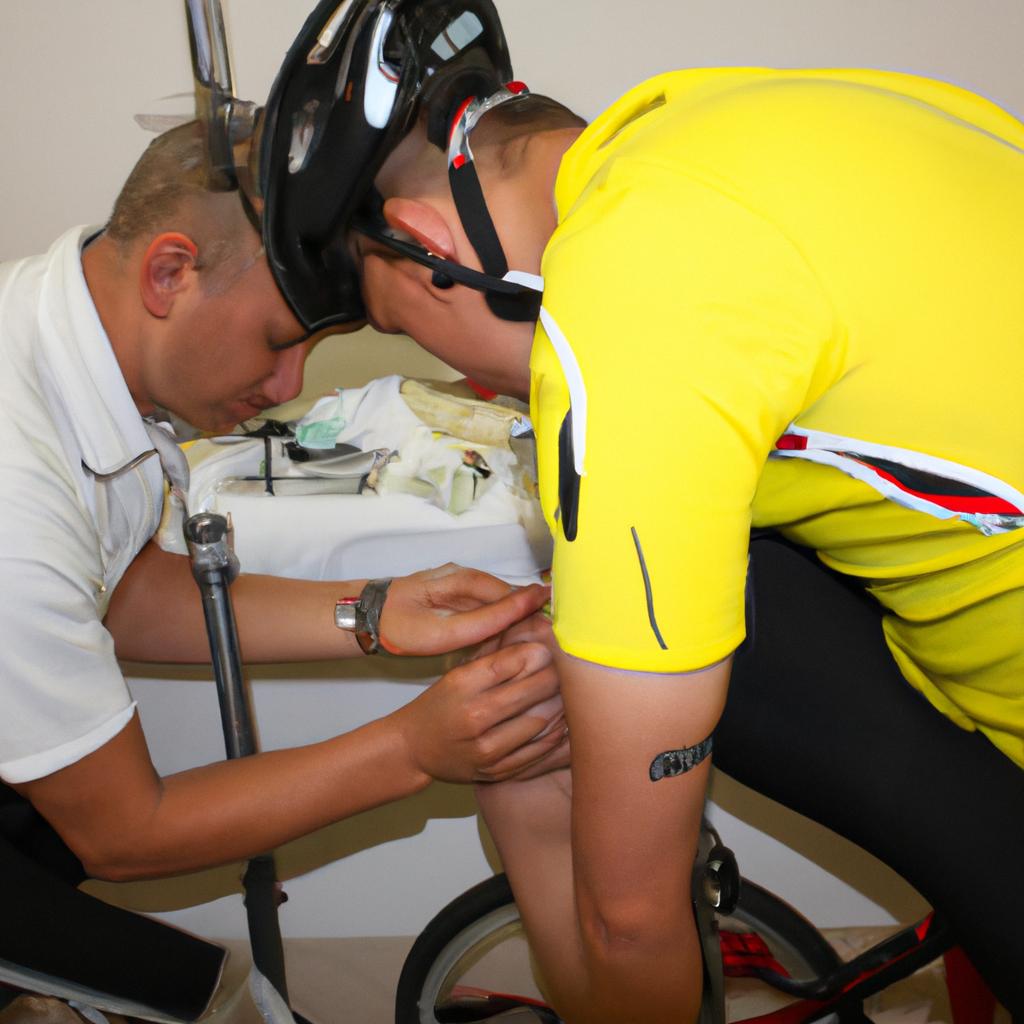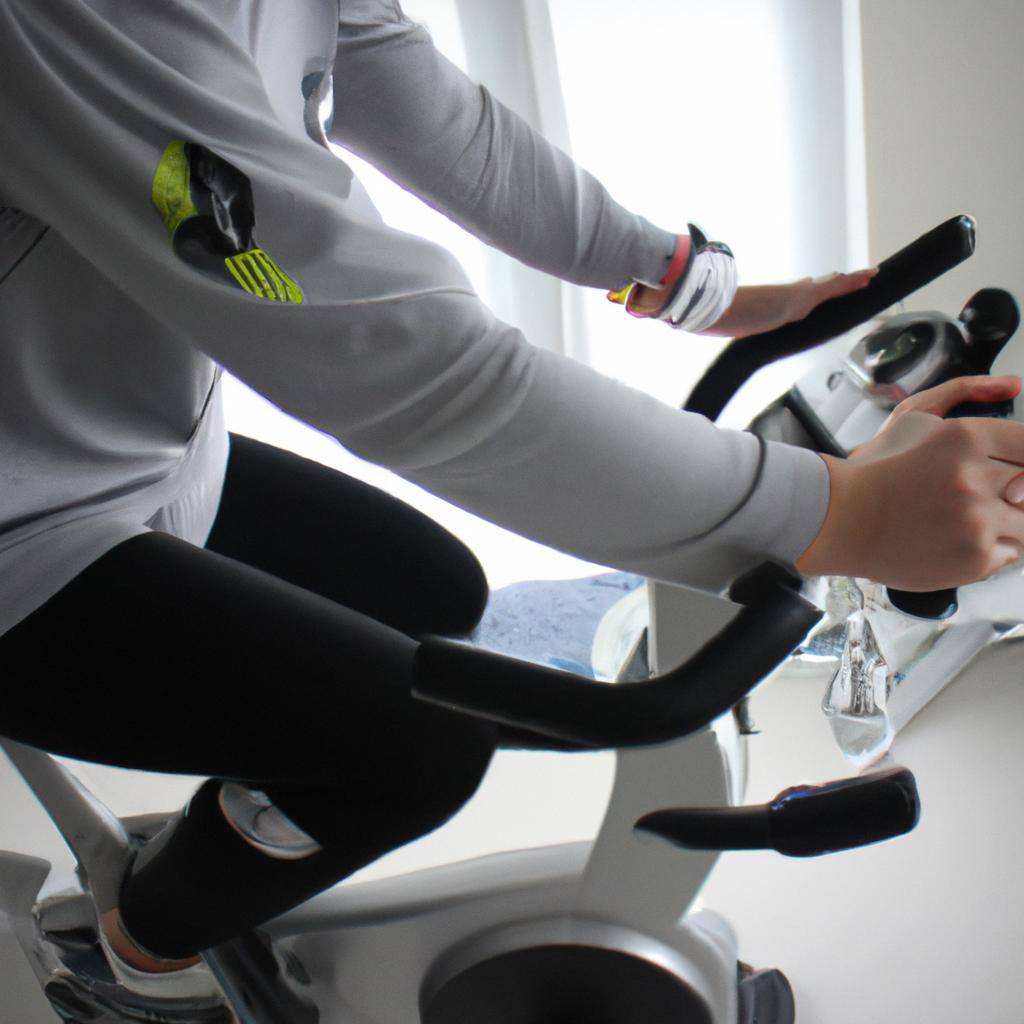Common Cycling Injuries: A Comprehensive Guide to Sports Cycling Injuries

Cycling injuries can be a common occurrence among sports enthusiasts, often resulting in pain and hindrance to physical performance. Whether it is a professional cyclist riding through challenging terrains or an amateur enthusiast exploring local trails, the risk of injury remains omnipresent. For instance, imagine a scenario where a passionate cyclist embarks on a long-distance ride only to find themselves experiencing excruciating knee pain halfway through their journey. This example highlights the potential impact cycling injuries can have on even the most dedicated riders.
Understanding the various types of cycling injuries and their underlying causes is crucial for both cyclists and healthcare professionals alike. Cycling-related injuries encompass a wide range of conditions that can affect different parts of the body, including but not limited to the knees, hips, back, neck, and wrists. These injuries may arise from factors such as improper bike fit, overuse due to excessive training volume or intensity, inadequate warm-up routines before rides, or simply accidents during cycling activities. Thus, this comprehensive guide aims to provide valuable insights into common cycling injuries while delving into their etiology and potential preventive measures. By examining these aspects thoroughly, individuals involved in sports cycling will gain essential knowledge to minimize the risk of injury and optimize their overall cycling experience.
Types of Cycling Injuries
Imagine a scenario where a passionate cyclist named Mark embarks on a long-distance ride. As he cruises along the scenic countryside, enjoying the fresh air and adrenaline rush, disaster strikes unexpectedly. Suddenly, Mark loses control of his bike due to an uneven road surface, resulting in a painful fall that leaves him with multiple injuries. This unfortunate incident highlights the potential dangers cyclists face while indulging in their beloved sport.
Cycling injuries can vary widely in nature and severity. It is essential for both recreational and professional cyclists alike to be aware of these potential risks to ensure they take appropriate precautions. The following list provides an overview of common cycling injuries:
- Fractures: Cyclists are particularly susceptible to fractures, especially those involving the upper extremities like wrists or collarbones. These fractures often occur when riders attempt to break their fall using outstretched arms.
- Road Rash: A term commonly used among cyclists to describe abrasions caused by skidding across rough surfaces after falling from the bike. Road rash injuries can range from minor scrapes to deep wounds requiring medical attention.
- Strains and Sprains: Overuse or sudden movements during cycling can lead to strains and sprains in various muscle groups or joints such as knees, ankles, or shoulders.
- Concussions: Head injuries are a significant concern for cyclists involved in accidents or falls at high speeds. Concussions may result from direct impact with another object or simply hitting one’s head on the ground.
To better understand the frequency and severity of these injuries, let us consider some statistics presented in Table 1 below:
| Type of Injury | Frequency (per year) | Severity |
|---|---|---|
| Fractures | 25,000 | High |
| Road Rash | 50,000 | Moderate |
| Strains/Sprains | 75,000 | Low |
| Concussions | 10,000 | High |
Table 1: Frequency and Severity of Common Cycling Injuries
In conclusion, the types of cycling injuries can range from fractures and road rash to strains/sprains and concussions. Understanding these potential risks is crucial for cyclists’ safety and well-being. However, it is equally important to identify the underlying causes that contribute to such injuries. The subsequent section will delve into the various factors responsible for causing cycling injuries.
[Transition] Now, let us explore the causes of cycling injuries and gain insights into how they can be prevented.
Causes of Cycling Injuries
Imagine a scenario where an avid cyclist, Sarah, is out on her usual morning ride when suddenly she loses control and falls off her bike. She ends up with a fractured collarbone, one of the many types of injuries that cyclists can experience. Understanding these various injuries is crucial for both cyclists and healthcare professionals as it enables them to identify and manage potential risks effectively.
Cycling injuries can be classified into four main categories: traumatic, overuse, contact-related, and environmental. Traumatic injuries occur due to sudden impact or forceful accidents, such as fractures, dislocations, or concussion caused by falling off the bike. Overuse injuries are typically repetitive stress injuries resulting from excessive strain on certain body parts over time. Examples include tendonitis in the knees or wrists and lower back pain.
Contact-related injuries arise from incidents involving collisions with other objects or individuals while cycling. These may result in abrasions, lacerations, sprains, or even broken bones. Finally, environmental injuries encompass harm caused by external factors like extreme weather conditions (such as frostbite), exposure to UV radiation leading to sunburns or skin cancer risk, and respiratory issues due to air pollution.
To illustrate the emotional toll cycling injuries can have on individuals affected by them, consider the following bullet points:
- The frustration of having to put physical activities on hold during recovery.
- Anxiety about returning to cycling after experiencing a severe injury.
- Loss of independence due to limited mobility during rehabilitation.
- Concerns regarding long-term implications on overall health and well-being.
In addition to understanding the different types of cycling injuries that exist, it is essential to recognize their prevalence among cyclists. The table below provides an overview of common cycling injuries based on data collected from various studies conducted worldwide:
| Injury Type | Prevalence (%) |
|---|---|
| Fractures | 25% |
| Contusions | 20% |
| Sprains | 15% |
| Concussions | 10% |
As we delve deeper into the causes of cycling injuries in the following section, it is crucial to remember that prevention plays a significant role in mitigating these risks. By adopting appropriate safety measures and understanding potential hazards, cyclists can reduce their chances of sustaining injuries while enjoying their beloved sport.
Transitioning smoothly into the subsequent section about “Prevention of Cycling Injuries,” it becomes evident that taking proactive steps towards injury prevention is paramount for maintaining both physical and emotional well-being on the bike.
Prevention of Cycling Injuries
Causes of Cycling Injuries and How to Prevent Them
Imagine a scenario where an avid cyclist named Sarah embarks on her usual morning ride through the scenic countryside. As she navigates along winding roads, enjoying the fresh air and picturesque views, disaster strikes – a sudden collision with a pothole sends her flying over the handlebars, resulting in a fractured wrist. This unfortunate incident highlights just one example of how cycling injuries can occur unexpectedly, even for experienced riders.
To minimize the risk of such incidents and promote safe cycling practices, it is crucial to be aware of the common causes of cycling injuries and take preventive measures accordingly. Here are some key factors that contribute to these injuries:
- Road Hazards: Uneven surfaces, potholes, debris, and other obstacles pose significant dangers to cyclists. It is essential to remain vigilant while riding and anticipate potential hazards ahead.
- Traffic Accidents: Collisions with motor vehicles account for a substantial number of cycling injuries. Adhering to traffic rules, using designated bike lanes or paths whenever possible, and wearing bright clothing or reflective gear can help reduce the likelihood of accidents.
- Overexertion: Pushing oneself too hard without adequate rest or recovery time may lead to fatigue-related injuries such as muscle strains or stress fractures. Listening to your body’s signals and incorporating proper rest days into your training regimen is vital.
- Equipment Failure: Faulty brakes, worn-out tires, loose chains – equipment malfunctions can have disastrous consequences while cycling. Regular maintenance checks and promptly addressing any issues are crucial steps toward preventing accidents caused by equipment failure.
Taking proactive measures can significantly reduce the chances of sustaining cycling-related injuries:
- Always wear appropriate safety gear such as helmets, knee pads, elbow guards, and gloves.
- Maintain good visibility by using front and rear lights during low-light conditions or at night.
- Observe road signs diligently and follow traffic regulations strictly.
- Stay alert and maintain situational awareness while riding, especially in high-traffic areas.
By understanding the causes of cycling injuries and implementing effective preventive measures, cyclists can reduce their risk of accidents and promote a safer riding environment. In the subsequent section, we will delve into common cycling injuries that primarily affect the lower body, exploring their causes, symptoms, and potential treatment options.
Common Cycling Injuries in the Lower Body: Causes, Symptoms, and Treatment
Common Cycling Injuries in the Lower Body
Imagine a cyclist named Sarah who frequently rides her bike to work. One day, as she was cycling along her usual route, she suddenly felt a sharp pain in her knee. This incident highlights one of the most common injuries that cyclists experience – knee pain. However, there are several other lower body injuries that can occur while engaging in sports cycling.
To prevent these injuries and ensure a safe cycling experience, it is crucial to understand their causes and risk factors. Here are some key points to consider:
- Proper bike fit: Ensuring that your bicycle is adjusted correctly for your body size and proportions can help alleviate stress on your joints and muscles.
- Warm-up exercises: Performing dynamic stretches before starting your ride helps prepare your muscles for the physical demands of cycling.
- Gradual increase in intensity: Avoid sudden increases in training volume or intensity, as this can put excessive strain on your lower body.
- Appropriate footwear: Wearing properly fitted cycling shoes with good arch support and stiff soles can enhance pedal efficiency and minimize foot-related injuries.
In addition to these preventive measures, understanding the specific types of lower body injuries commonly associated with cycling is essential. The following table provides an overview of some prevalent lower body injuries among cyclists:
| Type of Injury | Symptoms | Causes | Treatment |
|---|---|---|---|
| Patellofemoral Pain Syndrome (PFPS) | Knee pain at the front of the knee during or after riding; worsens when going uphill or climbing stairs. | Overuse, improper alignment of patella (kneecap), muscle imbalances. | Rest, ice packs, physical therapy exercises targeting quadriceps strengthening and stretching. |
| IT Band Syndrome | Sharp pain on the outer side of the knee; may radiate up to the hip or down towards the shin. | Overuse, poor bike fit causing lateral compression on the IT band. | Rest, ice packs, foam rolling or stretching exercises targeting the IT band and hip muscles. |
| Achilles Tendinitis | Pain and stiffness in the back of the heel or lower calf; worsens during or after cycling. | Overuse, tight calves, improper bike fit causing excessive ankle movement. | Rest, ice packs, gentle stretching exercises for the calf muscles, orthotic inserts if necessary. |
| Shin Splints | Dull pain along the inner edge of the shinbone (tibia); may progress to sharp pain with continued activity. | Overuse, muscle imbalances, poor foot alignment on pedals. | Rest, ice packs, physical therapy exercises targeting leg strengthening and flexibility. |
By understanding these common lower body injuries and implementing preventive measures like proper bike fit and warm-up exercises, cyclists can minimize their risk of injury while enjoying sports cycling.
[Transition Sentence]: Moving from the lower body to upper body injuries brings attention to a different set of potential issues that cyclists face during their rides without sacrificing safety and performance.
Common Cycling Injuries in the Upper Body
Imagine a scenario where a cyclist is cruising down a hill, enjoying the wind rushing through their hair. Suddenly, they lose control and are thrown off their bike, landing hard on their outstretched arm. This unfortunate incident highlights one of the common cycling injuries in the upper body – fractures or dislocations caused by falls or accidents.
In addition to fractures and dislocations, cyclists often experience other upper body injuries due to repetitive strain and overuse. These include:
- Shoulder impingement: The repeated motion of reaching forward while gripping the handlebars can lead to inflammation and compression of tendons and muscles in the shoulder.
- Wrist sprains: Cyclists may suffer from wrist sprains when they brace themselves during falls or put excessive pressure on their wrists while gripping the handlebars.
- Elbow bursitis: Extended periods of leaning on the elbow pads can cause irritation and swelling of the bursa sacs around the elbow joint.
- Nerve entrapment syndromes: Prolonged compression on nerves such as ulnar nerve (resulting in “handlebar palsy”) or median nerve (leading to carpal tunnel syndrome) can occur during long rides.
- Physical pain that hampers daily activities
- Limited mobility affecting work productivity
- Psychological distress due to inability to engage in beloved sport
- Financial burden from medical bills and potential time off work
Furthermore, let’s explore a table outlining some statistics related to upper body cycling injuries:
| Type of Injury | Prevalence | Common Causes | Affected Areas |
|---|---|---|---|
| Fractures | 25% | Falls or collisions | Arms, shoulders |
| Dislocations | 10% | Accidents, high impact | Shoulders, elbows |
| Shoulder Impingement | 35% | Repetitive motion | Shoulders |
| Wrist Sprains | 15% | Falls, excessive pressure on wrists | Wrists |
As cyclists strive to recover from these upper body injuries and regain their fitness, it is crucial to understand the appropriate treatment methods. The subsequent section will delve into various strategies for treatment and recovery of cycling injuries.
Understanding how to effectively address these injuries is essential in promoting a speedy recovery. Let’s now turn our attention to the treatment and recovery process for cycling injuries.
Treatment and Recovery for Cycling Injuries
Common Cycling Injuries in the Upper Body often result from poor posture, improper bike fit, or repetitive strain. One example of such an injury is shoulder impingement syndrome, where the tendons in the shoulder become compressed and irritated. An individual suffering from this condition may experience pain when lifting their arm or reaching overhead. To prevent upper body injuries while cycling, cyclists should focus on maintaining proper form and ensuring their bike fits them correctly.
To address common cycling injuries in the upper body effectively, it is essential to understand the treatment options available. Here are some key strategies for managing these injuries:
- Rest and Recovery: Allow sufficient time for rest to help reduce inflammation and promote healing.
- Physical Therapy: Engage in exercises that target specific muscles groups to strengthen weak areas and improve flexibility.
- Pain Management: Utilize non-steroidal anti-inflammatory drugs (NSAIDs) or other prescribed medications as directed by a healthcare professional.
- Bike Fit Adjustment: Consult with a professional bike fitter to ensure your bike is adjusted properly for optimal alignment and comfort.
It’s important to note that each injury requires an individualized approach based on its severity and unique circumstances. Consulting with a medical professional specializing in sports medicine can provide tailored guidance regarding treatment plans.
In understanding how various factors contribute to upper body injuries during cycling, we can adopt preventive measures to mitigate these risks. Cyclists must prioritize correct posture, regularly perform stretching exercises targeting relevant muscle groups, and maintain overall fitness levels. By taking proactive steps towards preventing injuries, individuals can enjoy safe and fulfilling experiences while engaging in sports cycling activities.
| Injury Type | Symptoms | Treatment | Prevention |
|---|---|---|---|
| Shoulder Impingement | Pain when lifting arms | Rest, physical therapy | Maintain good posture; regular stretching routine |
| Wrist Tendinitis | Swelling and pain in the wrist | Ice, rest, physical therapy | Use ergonomic grips; adjust bike fit |
| Elbow Tendonitis | Pain on the outside of the elbow | Rest, ice, physical therapy | Maintain proper handlebar position |
| Neck Strain | Stiffness and discomfort | Heat/ice packs, stretching | Strengthen neck muscles; maintain correct posture |
In summary, upper body injuries are a common occurrence among cyclists. However, with adequate knowledge about prevention and treatment strategies, individuals can minimize their risk and recover effectively. By adopting appropriate measures to address these injuries early on and seeking professional guidance when needed, cyclists can continue enjoying their passion for sports cycling while prioritizing their overall well-being.






